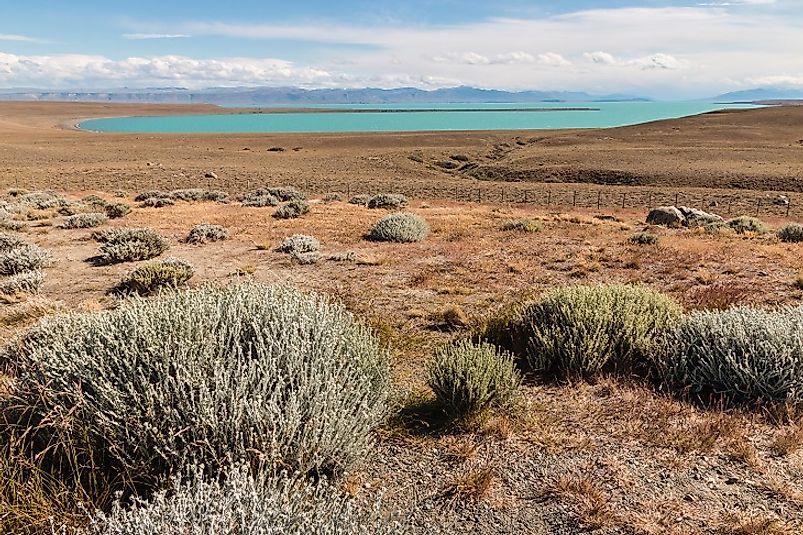Where Does The Patagonian Desert Lie?

5. Description
The Patagonian Desert stretches across an area of 673,000 square kilometers in the southern part of mainland Argentina and parts of Chile. The desert, also known as the Patagonia Steppe or Magellanic Steppe, is bounded by the Patagonian Andes to the west, the Atlantic Ocean to the east, and the Colorado River to the north. Though the Strait of Magellan can be regarded as the southern boundary of this desert, the same desert landscapes extend further down into the Tierra del Fuego region. The topography of the Patagonian Desert is wide and varied, comprised by tablelands, massifs, valleys, canyons, and lakes of glacial origin.
4. Historical Role
The Patagonian Desert was inhabited by hunter-gatherers since a long time ago. The Tehuelche Indians were the original settlers of this land, and there settlements here probably existed as far back as 5,100 years ago. Guanaco and rhea were the most important animals hunted by these ancient native tribes. Later, first the Spaniards, and then the English, tried to establish colonial settlements along the Patagonian coastal region in the late 18th and early 19th Centuries, but permanency of these settlements failed to exist. Years after the independence of Argentina, the native Indians were ousted from the Patagonian region during the Conquest of Desert Campaigns in the 1870s waged by the Europeans. The new settlers primarily occupied the region to exploit its enormous wealth of natural resources, including the vast mineral deposits of the region. Animal agriculture also was adopted as a source of livelihood by these new desert dwellers.
3. Modern Significance
The Patagonian Desert attracts a large number of tourists each year to Argentina. The presence of rare, unique, and often endemic flora and fauna, coupled with the rugged, wild beauty of the Patagonian landscapes, has fostered the creation of a large number of national parks in the area, and these are serving as major tourist attractions. Scientific researchers and geologists also visit the area to study the ecology, glaciology, and mineral wealth of this desert's habitats. The steppe vegetation of the desert supports a large community of livestock, especially sheep, which are reared by the ranchers living and working in the Patagonian Desert region. Peaches, almonds, alfalfa, dates, olives, and grapes are some of commercially significant crops cultivated here. The Patagonian Desert also hosts vast mineral reserves of iron ore, manganese, uranium, zinc, copper, and gold.
2. Habitat and Biodiversity
Two climatic zones prevail in the Patagonian Desert. The northern, semiarid zone has a mean annual temperature ranging between 12o and 20° Celsius, and annual rainfall there varies between 90 and 430 millimeters. The southern zone has a cold, dry climate, with mean annual temperatures ranging between 4o and 13° Celsius, and annual precipitation, including snow and rain, varies between 5 and 8 inches. The different parts of the Patagonian Desert have their own distinctive eco-regions as well. A narrow strip in the western parts of the region support a mix of deciduous and coniferous forests, and the density of vegetation gradually decreases from north to south. Monte vegetation and open bushlands are found in the northern zone, while the southern zone has extremely sparse, low-lying vegetation. Bird life in the Patagonian Desert is diverse, including peregrine falcons, Patagonian mockingbirds, and Patagonian yellow finches. Mammals like Southern viscachs, pumas, guanacos, and Patagonian weasels, amphibians like the endangered Andalgala water frogs, Argentine toads, and Gray four-eyed frogs, and reptilians like King's tree iguanas, Darwin's marked geckos, and Darwin's iguanas, are also found in the Patagonian Desert's varied habitats.
1. Environmental Threats and Territorial Disputes
The Patagonian desert vegetation is being continually lost to overgrazing by livestock, especially sheep, and occasionally cattle. This is leading to a rapid loss of ecological balance in the region. Approximately 30% of the Patagonian steppes are facing severe desertification, and more than 90% of the region suffers from soil degradation. The native fauna of the region is also facing tough competition from ranchers' grazing livestock in terms of food resources on the sparsely vegetated desert steppe lands. Many ranchers also tend to poison large native carnivores like foxes and pumas in fear that these might attack their livestock. The native wild species are also hunted for their body parts, meat, skin, and feathers, or just for sport, leading to rapid declines in the populations of many species. Raging wildfires in the Patagonian steppe also threatens the biodiversity of the region. Already, a large number of native species, such as the endangered South Andean huemul, the critically endangered Hooded grebe, and the near threatened Patagonian mara, are fighting to survive the odds in their threatened ecosystems.











